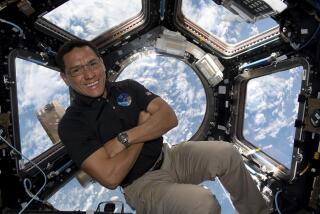Soviets Still High on Yuri Gagarin, First Man in Space
- Share via
MOSCOW — He was the Soviet Lindbergh, a cosmic Columbus. Twenty-five years after riding a rocket into history, Yuri Gagarin is still a heroic figure in his native land.
In a country of state-manufactured heroes--Gagarin’s Hero of the Soviet Union medal was numbered 11,175--the first man in space was the real thing.
A quarter-century later, and 18 years after his death in an airplane crash, every Soviet schoolboy knows of Gagarin. Busts of the youthful-looking cosmonaut are lined up on shelves of state shops beside those of Lenin.
A statue atop a 100-foot column towers over a square named after him in Moscow. His face peers out from posters and stamps. His daughter was chosen to open Moscow’s international youth festival last summer.
Attractive Person
“I remember that day in 1961, everyone was totally absorbed,” said a middle-age Russian woman. “He was a national hero. He was good looking, an attractive person--but it was because he was the first.”
Gagarin was 27 years old when he climbed into his Vostok spaceship April 12, 1961, and soared to fame. It was one orbit, a 108-minute ride. But the United States would take another 10 months to equal the Soviet feat.
“During the flight I saw for the first time with my own eyes the Earth’s spherical shape, you can see its curvature when looking to the horizon,” Gagarin told a news conference only one day after he opened the era of manned space travel.
“I must say the view of the horizon is unique and very beautiful,” the young major said. “It is possible to see the remarkably colorful change from the light surface of the Earth to the completely black sky in which one can see the stars.”
Symbol of Progress
Soon afterward he was dispatched on visits to Prague and Sophia, a living symbol of the technical progress accomplished under the Communist government. By July he was in London.
Thousands lined the 14-mile route from the airport, chanting “Ga-ga-rin” as the first spaceman rode in an open Rolls-Royce bearing the license plate YG-1.
Crowds swarmed everywhere during his five-day stay, with Prime Minister Harold Macmillan pronouncing him “a delightful fellow” and Queen Elizabeth inviting him for lunch.
It was fame that was undreamt of when the son of a collective farmer was growing up in the turmoil of World War II. Within two weeks of starting school in the Smolensk region, the German armies invaded.
Became a Foundryman
After the war his family returned and he continued the studies that turned him into a foundryman in 1951. He had bigger ambitions and in 1955 he entered the Orenburg air school to become a pilot.
After April 12, 1961, Gagarin never flew in space again. Instead, he toured 28 countries. Soviet leaders probably considered their hottest public relations property too valuable to risk when lesser-known cosmonauts were available for space.
If so, the concern was to no avail.
On March 27, 1968, after a long break from training, Gagarin took off on a routine flight in a MIG-15 jet fighter. Several minutes later he requested a standard course maneuver.
“Understood, fulfilling,” he confirmed. They were his last words.
Body in Wreckage
His body was found in the smoking wreckage, and the nation went into mourning. Again, thousands of Muscovites filed into Red Square. But unlike an earlier day of triumph the red flags this time were bordered in black.
Soviet leader Leonid I. Brezhnev, weeping openly, served as a pallbearer, and the ashes of the fallen hero were given a place of honor in the Kremlin Wall.
“To carry on the glorious cause started by Yuri Gagarin, we are prepared to continue the storming of the cosmos,” fellow astronaut Andrian Nokolayev said in a Red Square eulogy. “Nothing will stop us.”
Spacemen, both Soviet and American, have followed in his footsteps. But there is only one hero who started it all.
More to Read
Sign up for Essential California
The most important California stories and recommendations in your inbox every morning.
You may occasionally receive promotional content from the Los Angeles Times.













